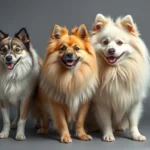
Introduction
Dog breeds represent the diverse variety of domesticated dogs categorized based on characteristics like size, temperament, and purpose. This classification is crucial as it significantly influences a dog’s behavior, care requirements, and suitability for various lifestyles. Among the multitude of breeds, the brown chocolate pug stands out as a unique and charming variation, capturing the hearts of dog lovers worldwide.
Overview of Dog Breeds
History of Dog Breeds
The evolution of dogs from wolves dates back thousands of years, where early humans began domesticating wolves for companionship and utility. Over time, selective breeding led to the development of specific breeds tailored for various roles, including hunting, herding, and companionship. Today, dog breeds reflect a rich history intertwined with human culture and needs.
Classification of Dog Breeds
Dog breeds are classified into several groups based on their characteristics and purposes. The primary categories include:
- Sporting: Dogs bred for hunting and retrieving.
- Working: Breeds designed to perform tasks like guarding and pulling.
- Herding: Dogs that assist in herding livestock.
- Hound: Breeds developed for hunting and trailing.
- Terrier: Known for their feisty behavior, originally bred to hunt vermin.
- Toy: Small breeds primarily bred for companionship.
- Non-Sporting: A diverse group not fitting into the other categories.
- Miscellaneous: Breeds that are still gaining recognition.
Breed standards, established by kennel clubs, outline the ideal characteristics of each breed, including physical attributes and temperament, ensuring consistency among breeders and helping potential owners understand what to expect.
Popularity of Dog Breeds
Over the years, the popularity of dog breeds has fluctuated due to various factors, including cultural trends, media influence, and changing lifestyles. The rise of social media has particularly impacted breed choices, with certain breeds gaining notoriety through celebrity ownership or viral videos.
Understanding the Pug Breed
History and Origin of Pugs
Pugs have a rich history that traces back to ancient China, where they were bred as companions for royalty. Their stocky build and charming demeanor quickly made them favored pets among the elite. As they traveled through trade routes, they gained popularity in Europe, particularly in the Netherlands and England, where they became known for their affectionate nature.
Physical Characteristics of Pugs
Pugs are small, muscular dogs typically weighing between 14 to 18 pounds. They feature a distinctive wrinkled face, a curled tail, and a short coat that can come in various colors, including fawn, black, and the unique brown chocolate shade. This rare coloration results from specific genetic combinations and adds to the breed’s visual appeal.
Temperament and Behavior
Pugs are known for their friendly, sociable, and playful personalities. They are excellent companions, thriving in family environments and getting along well with children and other pets. Their affectionate nature often leads them to seek attention and companionship, making them loving family members.
The Unique Characteristics of Brown Chocolate Pugs
Color Genetics
The brown chocolate pug derives its unique color from specific genetic factors. While traditional pug colors result from dominant and recessive genes, the chocolate coloration occurs due to a recessive gene that alters the pigmentation of the coat. This genetic variation makes brown chocolate pugs a rare and sought-after choice among pug enthusiasts.
Distinction from Other Pug Colors
Compared to traditional pug colors such as fawn and black, the brown chocolate pug stands out due to its rich, warm hue. While all pugs share similar body structures and temperaments, the chocolate coloration can also influence certain health aspects. Some argue that color may not directly impact health, but the rarity of brown chocolate pugs can lead to a higher price and, unfortunately, increased risk of unethical breeding practices.
Popularity and Demand
The demand for brown chocolate pugs has surged in recent years, driven by their unique color and charming personality. Social media has played a significant role in showcasing these dogs, leading to increased interest among potential pet owners. Their rarity also contributes to their allure, with many enthusiasts eager to own a one-of-a-kind pet.
Care and Maintenance of Brown Chocolate Pugs
Grooming Needs
Caring for a brown chocolate pug involves regular grooming to maintain their coat and overall health. Their short coat requires minimal brushing, but regular grooming helps reduce shedding and keeps their skin healthy. It’s essential to bathe them occasionally, especially if they engage in outdoor activities that may lead to dirt accumulation. Nail trimming should also be part of their grooming routine to prevent discomfort.
Dietary Requirements
Pugs, including brown chocolate pugs, have unique dietary needs due to their compact size and propensity for weight gain. It’s crucial to provide a balanced diet rich in high-quality protein, healthy fats, and essential nutrients. Monitoring food intake is essential to maintain a healthy weight and prevent obesity-related health issues.
Exercise and Activity Levels
Despite their small size, pugs require regular exercise to stay healthy and happy. Daily walks, playtime, and mental stimulation are vital for their well-being. Pugs can be prone to obesity, making regular physical activity essential for maintaining a healthy weight. Engaging in play that challenges them mentally and physically can also help prevent boredom and associated behavioral problems.
Health Considerations
Pugs, including brown chocolate pugs, are prone to certain health issues due to their brachycephalic (short-nosed) structure. Common concerns include respiratory difficulties, eye problems, and skin issues. Regular veterinary check-ups are essential to monitor their health and address any potential issues early. Additionally, the unique genetics of brown chocolate pugs may expose them to specific health concerns, so responsible breeding practices are crucial.
Training Brown Chocolate Pugs
Basic Training Techniques
Training is a vital aspect of raising a well-behaved brown chocolate pug. Early socialization and training help them develop into confident and well-adjusted pets. Positive reinforcement methods, such as treats and praise, work best for pugs, who respond favorably to encouragement rather than harsh discipline.
Behavioral Challenges
Like all breeds, pugs can exhibit behavioral challenges. Common issues include separation anxiety, stubbornness, and excessive barking. Understanding their temperament can help owners address these concerns effectively. Gradual training, consistent routines, and providing mental stimulation can alleviate many behavioral problems.
Advanced Training Opportunities
For those interested in pursuing advanced training, brown chocolate pugs can excel in agility or obedience competitions. Engaging them in training sessions that challenge their minds and bodies can enhance their overall well-being and strengthen the bond between dog and owner. Advanced training also provides excellent mental stimulation, keeping these intelligent dogs engaged.
Living with a Brown Chocolate Pug
Best Living Environments
Brown chocolate pugs adapt well to various living environments, making them suitable for apartments or houses. However, they thrive in homes where they receive plenty of attention and companionship. Families with children or other pets can provide a loving environment for these social dogs.
Socialization and Interaction
Socialization is crucial for pugs to develop well-rounded personalities. Regular interactions with other dogs and people can help them become more comfortable in various settings. Engaging in activities like dog parks or puppy classes can provide excellent opportunities for socialization.
Travel and Outings
Traveling with a brown chocolate pug can be a delightful experience. Their compact size makes them easy to transport, but it’s essential to ensure their comfort during trips. Always check for dog-friendly accommodations and plan outings that allow for breaks and exercise, keeping their needs in mind.
Conclusion
The brown chocolate pug is a unique and charming breed that stands out for its delightful personality and distinctive coloration. Understanding the characteristics, care requirements, and training needs of this breed ensures a fulfilling companionship. For potential pet owners, considering the specific traits of any breed, especially a unique one like the brown chocolate pug, is crucial to making an informed decision about welcoming a new furry family member into their lives.









